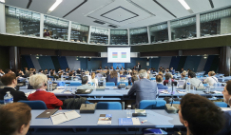Download “Media regulatory authorities and the challenges of cooperation” here
Freedom of expression and media pluralism are going through tough times at present. Instrumentalized COVID restrictions, rising populism and increasing media convergence with the bigger fish swallowing up the smaller have all come to represent a threat to these twin pillars of a functioning democracy. But the National Regulatory Authorities stand firm as the guardians of freedom of expression and pluralism in our broadcast and online media. They regulate, monitor and, where necessary, sanction media activity in Europe. And in order to do so they themselves must remain free from public or private interference in their decisions.
This new report – Media regulatory authorities and the challenges of cooperation – has just been published by the European Audiovisual Observatory, part of the Council of Europe in Strasbourg, in cooperation with the European Platform for Regulatory Authorities (EPRA). The report examines the current challenges facing National Regulatory Authorities and asks how cooperation between the various NRAs can strengthen their mission.
The scene setting first chapter paints a very diverse picture of NRAs in Europe. The different media regulatory authorities differ greatly in the way in which they are structured, the resources allocated to them (the majority of NRAs examined receive their budget directly from the State), their various powers and competences and, perhaps most crucially, their true independence and actual accountability to national governments, for example.
Chapter two walks the reader through the legislative framework in Europe in which the NRAs function and explains the various legal texts with a bearing on their work. The Council of Europe’s “Recommendation on the independence and functions of regulatory authorities for the broadcasting sector” adopted as early as 2000 paved the way for formal EU recognition of the role and importance of NRAs in the AVMSD. Other EU legislation such as the Digital Services Act Package are examined with reference to the NRAs. Obviously, the Commission’s planned Media Freedom Act will be of primary significance for the NRA’s role and functioning.
Chapter three offers in-depth profiles of national media regulatory authorities in seven different European countries. The authors examine the powers and competences of each NRA and drill down into the regulation of online platforms in each country. Will video-sharing platforms regulation fall under the responsibility of the media NRA or a separate body? And if so, how will the various authorities work together?
Chapter four examines the various networks of media NRAs which exist in order to cement and promote cooperation between different national bodies. The authors point out the two large overarching European networks, the EPRA and ERGA, and then go on to look at linguistically or geographically – oriented networking, based on the Francophone world, for example, or networking activity situated in the Baltic or Nordic areas.
Given the more recent challenges of the digital space, chapter five presents the various areas of cross-sectoral cooperation at national and European level. At a domestic level, national regulators with competencies in the digital space are increasingly recognizing the importance of cooperating on areas of mutual importance. This tendency has recently moved from an ad hoc phenomenon to more formalized cooperation structures between cross-sectoral regulators in the digital space – notably in the UK and in the Netherlands, for example. Recent EPRA research has highlighted many areas where enhanced coordination between sectoral regulators would be of benefit. Some areas include access to and collection of data, election regulation and targeted online political advertising, for example.
The authors round off with a state of play analysis of the shared challenges for NRAs across Europe. They conclude that the paradigm shift in the European media landscape may oblige media NRAs to reinvent themselves. The report points to the increased importance of sharing experience, guaranteeing enough resources for the NRAs to fulfill their mission, and possibly also the creation of common pools of experts at European level to support these guardians of freedom of expression and media pluralism in their mission.





